 This information has been archived for reference or research purposes.
This information has been archived for reference or research purposes.
Archived Content
Information identified as archived on the Web is for reference, research or recordkeeping purposes. It has not been altered or updated after the date of archiving. Web pages that are archived on the Web are not subject to the Government of Canada Web Standards. As per the Communications Policy of the Government of Canada, you can request alternate formats on the "Contact Us" page.
Current Operations
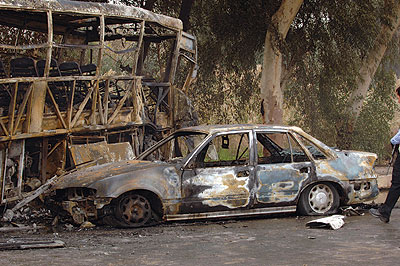
DefenseImagery.Mil DA-SD-07-06292
The aftermath of a suicide bombing.
Toward Solutions: Understanding Suicide Attackers in the Contemporary Middle East
by Tod Strickland
For more information on accessing this file, please visit our help page.
Introduction
Two truck bombs set off in quick succession sheared off the fronts of UN offices and a government building in Algeria’s capital Tuesday, killing at least 26 people and wounding nearly 200 in an attack claimed by an affiliate of al-Qaida... Al-Qaida’s self-styled North African branch’s Web posting said two suicide bombers attacked the buildings with trucks carrying 1,760 pounds of explosives each. Images were provided of the two ‘martyrs,’ identified as Ibrahim Abu Uthman and Abdul Rahman Abu Abdul Nasser Al-Aassemi.
– Herald-Zeitung, 11 December 20071
A suicide car bomber targeted offices of Iraq’s former prime minister and a Sunni lawmaker on Tuesday, speeding toward a checkpoint outside the buildings and killing two guards just outside the fortified Green Zone... The bombing took place in western Baghdad, less than 150 yards... from a series of buildings that included offices of Ayad Allawi, Iraq’s first post-Saddam prime minister and a secular Shiite, and those of Saleh al-Mutlaq, the head of the Iraqi National Dialogue Front, a Sunni bloc. Neither was at the offices at the time of the explosion.
– International Herald Tribune, 11 December 20072
A suicide car bomber attacked a Canadian convoy in southern Afghanistan today... No Canadians were injured but a teenager and a child were evacuated to a Kandahar hospital... The attack occurred around 3 p.m. local time as the convoy was returning to Kandahar Air Field after re-supplying Canadian troops in the field... A man in a grey van parked on the side of the road detonated his explosives as the lead vehicle in the convoy pulled up beside him.
– CTV News, 11 December 20073
They have become a ubiquitous and indelible element in Middle Eastern conflict within the contemporary world – the suicide attackers. On one day in December 2007, at least three incidents were reported in the international media, and they ranged geographically from Algeria to Afghanistan. The casualty count totalled at least 28 killed and a further 200 wounded. However, this was not an abnormal day. If anything, the toll of carnage could be described as comparatively light.
Suicide attackers are not a new phenomenon. Their first use was documented as early as 13 centuries ago.4 However, in the contemporary world, and, specifically, since the spring of 1983, there has been a significant and continued use of the tactic by at least 15 terrorist groups acting in a dozen different countries.5 After a period of relative disuse, suicide attacks took centre stage in April of that year, when a ‘kamikaze driver’6 rammed a truck bomb into the American Embassy in Beirut, destroying himself and his enemies in dramatic fashion. Less than six months later, on 23 October, another bomber killed 241 American marines and sailors in an infamous attack upon their barracks while most of the victims were still asleep on a Sunday morning.7 Twenty seconds later, a six-story building occupied by French paratroopers suffered an attack using the same modus operandi, leaving 58 dead.8 The world had just witnessed the rebirth of a ‘new’ weapon in the terrorist’s arsenal.
In the intervening quarter of a century, this form of violence has increased in use, and it appears to have become a permanent element of conflict around the world – but particularly in the Middle East. In Iraq, for example, between July 2006 and June 2007, there were 540 recorded attacks, which killed 1652 civilians.9 This methodology has been described by some as “the greatest moral monster of our time,”10 and yet, in spite of the invectives, it remains a poorly comprehended subject, surrounded by myth and misunderstanding. Concurrently, it causes numerous second and third order effects which are often just as detrimental, if not nearly as horrific, as the acts themselves. They decrease the money that is available to be spent on humanitarian aid by increasing the costs of security, alienating local populations, fuelling “sectarian revenge attacks” and “instill[ing] a sense of despair and chaos among ordinary citizens,” to name but a few of the effects generated.11 As historian Doctor David Whittaker noted in 2004, the constant threat forces a commensurate high level of readiness and security, with obvious economic impacts. In the case of Israel, the threat alone forces its government to keep its soldiers on extended periods of costly alert.12
Considering just a few of the aforementioned effects, it is apparent that the use of the suicide attack as an offensive weapon is one of the more significant intelligence issues in the modern Middle East. What are the organizations that exploit this means, and who are the people they use? Why have they adopted this form of terrorism to meet their aims? How are they supported? Perhaps most importantly, how can they be stopped? The intent here is to examine this phenomenon, focussing specifically upon the examples resident in the contemporary Middle East,13 in order to enhance general understanding of the issue, highlight some of the myths prevalent within conventional understanding of the issue, and finally, to offer some ideas as to how such attacks can be minimized.
To begin, some distinctions will be drawn within the topic itself, outlining how this particular form of terrorism has evolved. This will be followed by a discussion of who typically conducts attacks of this nature, and what motivates them to use this methodology. Subsequently, since a significant popular perception is that Islam supports the use of suicide attacks, what Muslim authorities actually say with respect to the subject will be covered. Lastly, the article will close with a brief discussion of some potential solutions.
Before proceeding further, it is worth briefly addressing why this tactic is increasing in frequency. Succinctly put, it is because the tactic is working and opposing and victimized elements have yet to find a credible, practical deterrent to mitigate its effectiveness. According to a noted expert on the subject, political scientist Robert Pape, suicide attacks are generally more destructive than conventional attacks, averaging 12 casualties per bomber. To further illustrate the point, according to Pape’s data, while suicide bombers conducted a scant three percent of all attacks between 1980 and 2003, they accounted for 48 percent of the casualties from acts of terror in the same period.14 Unless their effectiveness can be decreased, it is doubtful that we can remove their use as a weapon for the modern terrorist.

Liberal Party of Canada-Radey Barrack
Michael Ignatieff.
Distinctions and Evolution
The first point that needs to be emphasized is that there is a spectrum when it comes to suicide attacks, depending upon the intended targets. Those that involve solely military targets, whose purpose is not so much terrorism as defeating an enemy combatant, are different from those who attack civilians with the intent of terrorizing a given population. In the words of the Canadian politician and academic Michael Ignatieff:
Terrorism is the politics of the shortcut, a resort to force when peaceful means of political mobilization offer only a protracted and uncertain road to victory.15
Therefore, those that are using the methodology of a suicide attack to terrorize a population should be considered in a different category than those that are attacking a legitimate target in accordance with the laws and conventions of war.
Second, although the suicide bomber seems to have gained primacy of place within the mass media, this is not the only form of suicide attack. A suicide attack is appropriately viewed as one in which the attacker has no expectation of surviving the assault, who will die either by his or her own hand, or through the response of the survivors of his actions. Thus, an Israeli settler who enters a mosque in Hebron, killing 13 and wounding 60 before being overpowered by his intended victims and being himself killed,16 is as much an example of a suicide attack as any of the three cases at the beginning of this discussion.
The next point that needs to be clarified is the idea that ‘suicide’ and ‘martyrdom’ are different concepts. Even the individual words may carry different meanings for different peoples. Although this may seem a question of semantics, it is an important distinction that underlies the bigger question of whether the tactic is acceptable within the Islamic religion. Suicide, according to the Oxford Dictionary, is defined as “intentional self-slaughter.”17 This is different from a ‘martyr,’ which, in the Judeo-Christian tradition, the same reference defines as “...one who undergoes penalty of death for persistence in Christian faith or obedience to law of Church, or undergoes death or suffering for any great cause.”18 This is different from the concept of shaheed, the Muslim equivalent, which has been expanded upon by scholar Joyce Davis:
The word shaheed is commonly used to describe everyone from innocent children killed in war to gunmen opening fire in a crowded marketplace, even if such usage may not adhere to the religion’s true teachings...there are nevertheless certain criteria...anyone who is killed as a result of oppression or persecution...everyone who dies in the midst of battle defending his homeland or fighting evil is worthy of the ranks of the shuhada [martyrs]. Shuhada abide by Islam’s teachings on just war, which exclude harming women and children and which some authorities contend exclude suicide.19
It is important to note that while Western perceptions of martyrdom differ, even with the differences Islam demands that specific criteria be met in order for a person to be appropriately classified as a martyr.
The last preliminary point that should be addressed before moving on to the primary discussion is that suicide attacks have changed substantially since the first incidents in Lebanon in 1983. Specifically, the types of targets, the methods used and the attackers themselves have all shifted from those that the world witnessed initially there. The Israeli subject matter expert, I.W. Charney, has noted that the target sets have moved away from those that could be considered militarily legitimate (i.e., the marine barracks in Beirut), to the deliberate killing and wounding of civilians, such as at Sbarro pizza parlours in Israel.20 This can justly be viewed as a move towards terrorism, and away from a more legitimate form of warfare. Similarly, the perpetrators are no longer just men, and there has been a disturbing trend towards using both women and children in the accomplishment of the aims of terrorist movements. Charney further notes that “...up until March 26, 2004, there had been twenty-nine suicide bombers younger than eighteen who were dispatched by Palestinian terror organizations [into Israel].” In one disturbing case, he relates how a child was used to try to carry bags full of explosives from Palestine into Israel, and that, upon detection, attempts were made to detonate the explosives remotely.21 This points to yet another transformation. Initially, suicide attackers self-detonated, but recently, there have been examples of attackers being detonated by others from a distance. Taken together, these changes show that this issue is far from being static. Rather, the problem of suicide attacks is better viewed as being dynamic in nature, constantly changing as different solutions are trialed.
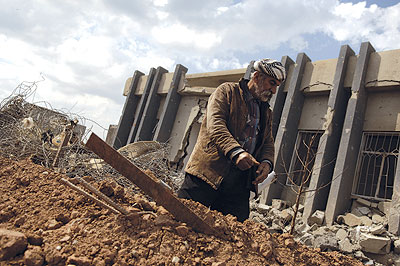
DefenseImagery.Mil 070404-F-2828D-105
More aftermaths.
Who Are the Attackers?
Trying to understand the attackers themselves is a starting point that is frequently used in the current literature on the topic, if for no other reason than because it begs the question as to why people would willingly destroy themselves to achieve a given purpose. Robert Pape has conducted a most detailed analysis of the topic, examining a significant number of attacks, as well as attackers who have either attempted or completed their tasks over the past quarter century. Pape’s results are disturbing, and they refute a significant portion of the conventional wisdom.
Few suicide attackers are social misfits, criminally insane or professional losers. Most fit a nearly opposite profile...psychologically normal...better than average economic prospects...deeply integrated into social networks and emotionally attached to their national communities. They see themselves as sacrificing their lives for the nation’s good.22
Similarly, Charney cites data collected by Marc Segeman, a Senior Fellow at the US Foreign Policy Institute and a specialist in terrorism and counter-terrorism who studied over 400 terrorists and showcased a profile of the attackers that many would not necessarily have expected. His data showed that 75 percent came from the upper or middle classes of their societies, with 90 percent coming from intact families, and 63 percent having been attendees at post-secondary institutions. Nearly three-quarters of them were married, as well as being employed in professional or semi-professional capacities.23 It is not necessarily young, deprived men that are carrying out these assaults.
This has been reinforced by researchers Efraim Benmelech and Claude Berrebi – who noted that out of 151 incidents that occurred in Israel between September 2000 and August 2005, “...the most spectacular....suicide attacks are frequently assigned to older and more educated bombers, who are most likely to succeed.”24 Further, they wrote that the “...five deadliest bombers were almost five years older on average... that three of them had or were pursuing advanced degrees,” and that “...younger and less educated bombers were more likely to detonate too early, get caught by authorities, or succumb to second thoughts.”25
With respect to nationality, it should not be taken for granted that a suicide attacker is a citizen of the country in which he acts. Scholars Rod Nordland, Babak Dehghanpisheh, and Larry Kaplow provide a compelling example of this in their report from August 2008 in Newsweek, where they observed:
...[that] the majority of the bombers are not Iraqi...Saudis account for half the suicide bombings in Iraq...Saudis play a little role in the insurgency as a whole but are key to the suicide-bombing campaign.26
Similar examples could be found in Afghanistan, and, undoubtedly, in Israel. In short, potential attackers are frequently travelling long distances in order to carry out their missions.
From a gender-based perspective, women have taken on active roles in the field, with female suicide bombers being reported in Israel and Iraq.27 In Israel, the first recorded use of a woman in this role appears to have occurred in January 2002, when a Palestinian woman, who had first suffered a miscarriage and then had been unable to conceive children, blew herself up. This followed her husband having stated that he wanted to take a second wife, to which the young subsequent bomber objected.28 Then, in 2004, a young woman feigned a handicap in order to gain the sympathy of Israeli soldiers at a checkpoint in Gaza. They were subsequently killed by the woman when she self-detonated in what constituted Hamas’s first use of a woman as a suicide bomber.29 This particular incident represents a watershed moment both in the history of Hamas and suicide attacks as it demonstrated that expediency and tactical effectiveness in the pursuit of political power “...was tastier than religion or family life values.”30
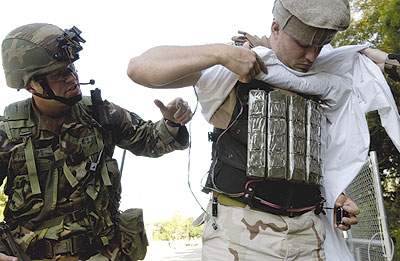
DefenseImagery.Mil 040505-F-9528H-021
Bomber training.
What Motivates Them?
Prior to moving into the realm of what might motivate an individual to become a suicide attacker, it is worth examining the ‘strategic logic’ of using the tactic as it has been explained by Robert Pape. The first point he makes is that at the organizational level “...coercion is the paramount objective of suicide terrorism.”31 Specifically, he argues that suicide attacks are part of “...[a] strategy of coercion, a means to compel a target government to change policy.”32 Further, Pape suggests that these types of attacks:
...[are] not isolated or random acts... but rather occur... as part of a larger campaign by an organized group to achieve a specific political goal. Moreover the main goals of suicide terrorist groups are profoundly of this world. Suicide terrorist campaigns are primarily nationalistic..., not religious...33
This is supported by public pronouncements, such as that of Hamas spokesman Mohammad al-Zahar who, in 1995, said:
We must calculate the benefit and cost of continued armed operations. If we can fulfill our goals without violence, we will do so. Violence is a means, not a goal.34
In short, such attacks can be viewed as a tactic of the weak, which aims to turn the Athenian’s adage to the Melians on its head. Instead of the “strong do[ing] what they can and the weak suffer[ing] what they must,”35 suicide attacks force the strong to suffer, while the weak act. In order to do this, suicide attackers generally are the “product of a three-step process,”36 which is comprised of the ‘strategic logic’ (the goals that will be attained), a ‘social logic’ (the social support necessary for the attack to succeed), and the ‘individual logic,’ (the motivation that empowers the individual to destroy himself in the execution of the attack.37 It is to the individual logic that we now turn our attention.
First, it must be acknowledged that there is no one single reason for someone to undertake a suicide attack.38 Terrorism expert Lauri Friedman, in her book What Motivates Suicide Bombers, listed no less than 11 different factors. These included glory, despair and hopelessness, poverty, Islam, anti-Semitism, nationalism, paradise, religion, revenge and television.39 Robert Pape distilled it down to three causes: nationalism, subjection to an occupying force, and religious differences.40
From the literature, it seems evident that politics and nationalism are powerful motivators to those that commit the attacks. An American senior officer, commenting upon the destruction of the marine barracks in Beirut, put it fairly bluntly when he stated: “There may have been a fanatic driving that truck, but I promise you there was a cold, hard, political, calculating mind behind the planning and execution of it.”41 When one examines the motivation of terrorist groups, this factor also figures prominently. In the words of Robert Pape, “al-Qaeda’s principal motive is to end foreign military occupation of the Arab Peninsula and other Muslim regions.”42 He goes on to note:
Suicide terrorism rarely evolves from tiny bands of ordinary terrorists [admittedly hard to define], but instead commonly arises from broad-based nationalist liberation movements, those that typically have pursued guerrilla-warfare and found that a guerrilla strategy is inadequate to achieve their nationalist aspirations.43
One Iraqi suicide bomber, in discussing the personal reasons for his actions, cited the occupation of his country, saying: “We expected them [the Americans] to bring Saddam down then leave... But they stayed and stayed.”44
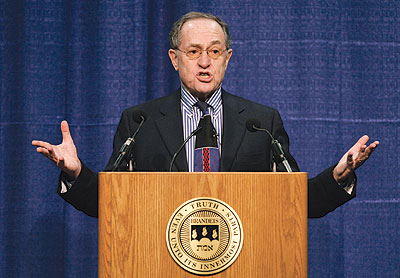
Reuters RTR1LJ8P
Alan Dershowitz.
Law professor and political commentator Alan Dershowitz has added to the list of possible motivations, arguing that the very success that suicide attackers sometimes achieve forms an important element in recruiting future bombers.45 This is echoed in the societal support that these individuals receive for their actions. Charney notes that summer camps have been named for successful bombers in Palestine, that trading cards exist, and that even soccer tournaments and individual teams commemorate those that have self-destructed while destroying their enemies.46 For an example of this type of support, one need only examine the words of the wife of the late Yasser Arafat, who said: “...if she had a son there would be ‘no greater honor’ than for him to become a suicide bomber.”47 These endorsements can be powerful incentives for some, particularly when they are linked to the system of rewards that await potential attackers, both in the earthly world and the afterlife.
In this world, there is a very tangible system of awards for successful bombers to bequeath to their families. As scholars Michael Arena and Bruce Arrigo articulated in their discussion of suicide bombers in Israel, bombers leave with financial stability assured for their families... scholarships for their siblings... and compensation for the family’s resettlement is guaranteed, should Israeli retribution claim their homes.48
The organizations that provide this support do not do so out of altruism. Rather, they have very real and defined goals. Specifically, they wish to minimize the moral backlash that suicide attacks might otherwise produce within the communities from which the attackers are drawn – they want to keep their recruiting base receptive. In the words of the German author and correspondent Christoph Reuter:
Hezbollah wants to persuade the world that [a] suicide bombing mission [is] just as much a part of life of a Shi’ite resistance fighter as getting married, bringing up children, leading a normal live. Hezbollah undertakes to pay all education and living expenses of the surviving immediate family.49
These rewards supposedly carry on in the after life, where martyrs can expect “sweet honey and holy wine... seventy-two virgin brides... seventy five passes to this paradise for their friends and relatives.”50 These rewards can easily be seen to powerful motivators to those seeking to induce others to join their cause.
Linkages to sex and gender have also been drawn as possible motivators, although these are somewhat more tenuous. In the case of gender, and in particular female attackers, some have cited that by volunteering for suicide missions, women may be afforded the opportunity to atone for infidelity or other honour-based cultural offences.51 With respect to sex, psychologists Alan Miller and Satoshi Kanazawa have postulated that there is a link between sexual frustrations on earth and the promise of release in paradise that motivates some. In their words “...it is the combination of polygyny and the promise of a large harem of virgins in heaven that motivates many young Muslim men to commit suicide bombings.”52
On a more concrete level, suicide terrorism appears to offer an opportunity for equality that eludes some in life. This has been commented upon by at least two authors. Nia Kfir points out “...[that] suicide terrorism is seen... as heroism that mega-overcompensates for inferiority and as a search for fulfilling peak experiences...”53 Further, she argues that suicide, while concurrently killing others, offers a means of equality with those viewed as exercising oppression over the weaker party.54 In a similar, if somewhat more disturbing vein, Robert Pape recorded the words of the secretary-general of Islamic Jihad, Fathi al-Shaqaqi, who stated in 1995: “If we are unable to effect a balance of power now, we can achieve a balance of horror...” Equality clearly has several different dimensions.55
What should be abundantly clear is that there are myriad reasons that could drive an individual to use him or herself as a weapon to destroy their enemies. As I. W. Charney explains:
Some want virgins. Some want fame and glory... Some want money for their family. Some are good soldiers... Some want revenge for specific loved ones... Some want revenge for their nation over their loss of world power... Some want... to kill infidel non-believers. Some want to obey... their leaders. Some want the excitement of belonging to a group... Some feel hypnotized or even coerced.56
There is no single answer.
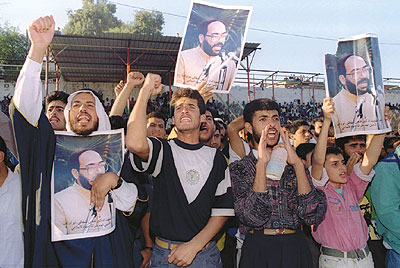
Reuters RTXFLHK
Supporters of Fathi al-Shaqaqi.
What Does Islam Say?
Although many have drawn a connection between Islam and terrorism, and suicide attacks in particular, the truth of the matter is somewhat more complex. Robert Pape has drawn the conclusion that suicide attacks are not, strictly speaking, solely an Islamic fundamentalist issue.57 While this is true, given the statistical evidence upon which Pape based his study, it would seem that Islamic extremism does play a significant role in the suicide attacks that take place in the Middle East. It is therefore important to garner an understanding of what current Muslim scholars say with respect to this form of attack. As with many arguments, there are two principal perspectives: those that condone the use of the tactic, and those that do not. Let us first examine the arguments of those who believe that Islam supports this methodology.
There is a significant body of Muslim clerics that supports suicide attacks, although they would not refer to it as such, opting instead to use a phrase akin to ‘martyrdom operations,’ and examples abound. In 1995, on the television network al-Jazeera, Muslim evangelist Yusuf al-Qaradawi justified suicide attacks stating: “These operations... are the highest form of jihad and are most certainly permitted by Shari’a.”58 He has also stated “...[that] suicide bombing [is] a supreme form of jihad for the sake of God and, therefore, religiously legitimate.”59 Some even cite the writings of cleric Taqi al-Din Ahmad Ibn Taymiy, who wrote in Turkey (with respect to fighting the Mongols) between 1263 and 1328, as giving sanction to those that would use suicide attacks.60
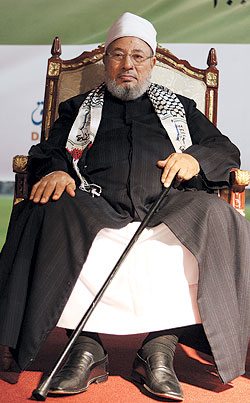
Reuters RTR22ZDA
Yusuf al-Qaradawi.
Alan Dershowitz recorded two additional endorsements:
In April 2002, Sheikh Muhammed Sayyed Tantawi, the leading Islamic scholar at al-Azhar University in Cairo declared that “martyrdom operations”... were the “highest form of jihad operations,” and that suicide attacks were “...an Islamic commandment until the people of Palestine regain their land...”
Similarly:
Dr. Ahmad al-Tayyeg, Egypt’s leading religious jurist, declared that the solution to Israel’s aggression lies in a proliferation of suicide attacks “...that strike horror into the hearts of the enemies of Allah.” He ruled “...[that] Islamic countries, peoples, and rulers alike must support these martyrdom attacks.”61
As can be seen, the two principal defences that some Muslims use is that the attack is a form of jihad, which is seen as a duty within the religion, and that it is not suicide on the part of the attacker. Rather, it is martyrdom. Thus it can be viewed as a “...deliberate, carefully chosen conduct as a function of their religious duty.”62 This is further evidenced in the language preferred by Hamas, who use the term ‘istishhadi’ (self chosen martyrdom) in describing those who conduct the attacks.63
In contemporary times, the sanction was first given by Shi’ite clerics supporting the Khomeini regime in Iran, and through them the terrorist group Hezbollah.64 They were the first to draw the link between action and the Islamic duty of Jihad, while concurrently distancing it from Islam’s prohibition on suicide; hence their phrasing the act as martyrdom. In the words of Sheik Naim Qassem: “We regard martyrdom as a Muslim’s choice of the manner in which he seeks to die.”65 Sheikh Hussein Fastlallah was the Shi’ite cleric who gave the original sanction to Hezbollah in 1997. Initially, he took a somewhat tentative approach to the matter. However, he later issued a Fatwa “...declaring suicide attacks legitimate, provided that the greatest possible number of enemies would be killed by them.”66
As Arena and Arrigo noted:
Karbala [martyrdom] is not an act of suicide...it symbolizes the supreme willingness to submit to the will of Allah with the understanding that rewards will come after death. Islam emphasizes that life on earth is merely a transition to a better life. A suicide bomber is making a transition that will put him or her alongside the other heroes of Islam and next to Allah.67
Importantly, these views are not held by all Muslims. Indeed, it is hard to determine an exact split of opinion, but for many, the views heretofore espoused are an anathema. In the bluntest possible terms, author Munwar Anees writes:
...whatever the pretence, these acts are in dire violation of the teachings of Islam. There is no Quranic support for taking one’s own life to kill and maim innocent children and women – even when in a state of war with the enemy. There is no evidence from the life of the Prophet that such acts were encouraged or permitted by him... [they are] the ultimate debasement of Islamic ideals.68
Taking the firm view that such attacks are not the acts of martyrs, he explains “...[that] the purpose of a Muslim’s life is to live for the pleasure of God.”69 Further, he writes:
Islam teaches that life is a sacred trust given to human beings by the Creator. Like other Abrahamic faiths, it prohibits suicide as a grave sin. It is forbidden under all circumstances, including war.70
This perspective is echoed by other writers. Christoph Reuter argues that pre-meditated martyrdom is in effect suicide to traditional Islamic legal scholars.71 He goes on to say “...[that] the religious authorities of traditional Islam... condemn those who commit suicide for ignoring the authority of God.”72 He cites the example of the Egyptian al-Manfaluti, who wrote at the beginning of the 20th Century “...[that] the idea of suicide is truly an inclination of the devil, thus there’s no forgiveness for the man who commits it.”73
Following the attacks of 9/11, Sheikh Muhhammad Sa’id al-Tantawi, who headed the al-Azhar in Cairo, “...declared that the Shari’a rejects all attempts on taking human life.”74 Similarly, Sheikh Muhammad bin ‘Abdallah al-Sabil “...decried the suicide attacks on the basis that Islamic law forbids killing civilians, [and] suicide...”75 Although, as author David Bukay noted, both authors avoided the concept of ‘martyrdom’ in their pronouncements, their statements are clear demonstrations that at least some targets of suicide attackers are expressly forbidden.
A final word in support of the argument that Islam does not support the use of suicide attacks is offered by the Pakistani writer and social critic Doctor Munwar Anees:
There is no Quaranic evidence to support the myth of multitudes of perpetually regenerating virgins in paradise, the Qur’an unequivocally condemns the perpetrators of suicide to hell...76
What is clear is that there are elements of the Islamic faith that support the use of suicide attacks, and there are those that condemn its use. However, let us now move on to a discussion of how this form of attack can be minimized, or perhaps even eliminated.
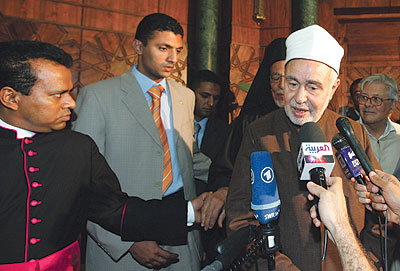
Reuters RTR1HHQX
Sheikh Muhhammad Sayyed al-Tantawi.
Stopping Them
At first glance, the problems posed with defeating those that would destroy themselves in order to destroy their enemies seems like an example of a “wicked problem,”77 but this may not be the case. With creativity and ingenuity, there are different lines of defence that can be undertaken to at the very least minimize the threat that they pose. Specifically, there are potential responses that cut across all elements of public power and private enterprise that could drastically impact the ability of terrorist organizations to recruit and support potential attackers, and to minimize the effectiveness of the attackers themselves. Robert Pape argues that there are two principal goals to any campaign against attackers, the first being “...[to] defeat the current pool of terrorists,” and the second “...[to] prevent a new, potentially larger generation from rising up.”78 All our efforts should be undertaken as part of a comprehensive campaign with those two goals in mind. Arguably, the first step is detailed here by I.W. Charney:
...what is... needed... are ways of mobilizing greater criticism and rejection of suicide bombers in the minds of people around the globe, as opposed to their being welcomed, honored, supported or even “understood” by too many peoples, nations, and religions.79
From a religious-based approach, those religions that are witnessing their members twist the teachings that they have been given (whether Jewish, Christian, or Muslim), need to take action. In the words of one Muslim writer:
Muslims have the responsibility to take Islam out from the hands of those who misapply it.... to the circles who feel sympathy with terror, it should be made clear that terror is utterly against Islam and that it only serves to harm Islam, Muslims and humanity at large.80
The same sentiments are equally applicable to the other religions of the region. One should not allow state or private broadcasters to send out messages of hate that appear to give God’s permission for these horrendous attacks to take place. By taking religious sanction out of the equation, one deprives potential recruiters of one avenue with which to entice potential candidates.
There exists a need to push for policies similar to Canadian anti-hate laws to be enacted within the governments of the Middle East. As suggested by Charney: “Holy leaders... cannot be allowed to preach murder, sedition, terrorism or violent revolution.”81 To some this will appear as an affront to free speech. However, such limitations are both reasonable and prudent. Institutions that would destroy democratic principles should not be afforded the protection of those same principles in the advancement of their goals. Reasonable limitations against messages of hate and destruction, and advocating the use of suicide tactics, should be strongly considered. Tony Blair, the former British prime minister, went so far as to suggest the closing of mosques and the deportation of religious leaders who fostered “...hatred and violence.”82 These ideas need to be given serious consideration.
Socially, there is a need to stop the celebration of martyrdom. This could be done in several ways. First, by education and aggressive marketing within the Middle East, the potential exists to sway elements of the population whose opinions matter, namely, mothers. As one mother of an Iranian martyr noted: “I can’t presume to judge... but I don’t believe it’s God’s will for someone to just throw his life away.”83 If this attitude can be made prevalent in the region, perhaps it will result in a decrease in the number of sons and daughters who ‘throw their lives away.’ This becomes all the more possible when it is recognized that the mother is a powerful element in Muslim society. One cannot afford to disregard this avenue of approach.
Another means is to use the ‘carrot and stick’ approach by either providing or withholding developmental and foreign aid to governments within the region, based upon their stance on an issue, as well as by the visible means that they are undertaking to stop suicide attacks from occurring. Increased developmental aid and enhanced diplomatic relationships could be afforded to those countries that stop hatred from being preached in their mosques, which undertake campaigns to educate their populace, which ban the naming of sports events and recreational activities for martyrs, which stop showing funerals for martyrs on public airwaves and essentially vilify those that would condone suicide attacks. States that either actively support terrorist activities, or permit suicide terrorists to act in their name, should see their developmental aid evaporate and their diplomatic avenues close until such time as they denounce this method of confrontation. There is no reason that Western governments should permit the funding or passive support of terror.
We need to devote special attention to the organizations that enable suicide attacks to take place. The first course of action is to cut funding – both from governments that provide it (Iran to Hezbollah) and from citizens within western democracies. Much as the United States has enacted legislation banning the collection of funds to support the ‘Tamil Tigers,’ Western governments need to create similar legislation that forbids soliciting for funds that will be used to support conflict in another state.
A second means is to use the rule of law, and, in particular, international humanitarian law to target the leadership of organizations and countries that support suicide attacks. Although the application of statutes aimed at these individuals may prove difficult, its existence alone would be a disincentive to those that would advocate using suicide bombers in the attainment of their goals. Allan Dershowitz has expressed it as follows:
...a desire for martyrdom need not eliminate all possibilities of deterring the act by threatening severe punishment. It merely requires that the severe punishment be directed against someone, or something, other than the potential martyr himself, such as his cause, or those who harbor him.84
This points to the fact that the organizational networks that support the attackers need to be studied and analysed in order to determine where they can be challenged in order to cause maximum disruption. Some, such as specialists in Middle Eastern studies Doctors Ami Pedahzur and Aeri Perliger, advocate striking the hubs of the social networks rather than attempting the same thing in the traditional hierarchical ones, akin to a military chain of command.85 At the very least, the approach warrants consideration.
While the aforementioned means tend to target the societies and the organizations that support suicide terror, there are also practical means that can be used to minimize the effect of suicide attackers as they attempt to complete their missions. Technology needs to continue to be developed to permit protection of static vital points, as well as allowing the mobile detection and disruption of attackers. As one journal noted, technology is being developed that can scan personnel from up to 100 metres away, and can detect bombs using low-powered radar.86 Similarly, the use of specially-trained dogs that can detect suicide attackers by reading body language and facial expressions are now being used in Iraq.87 These innovations could help considerably in defeating suicide attacks.
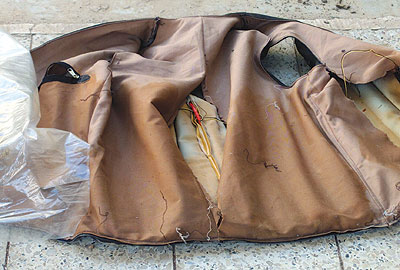
DefenseImagery.Mil 03412-M-0049F-083
A typical suicide vest.
Conclusion
Suicide attacks in the Middle East have a much broader effect upon the world at large, and, whether a strike takes place in Algeria, Iraq, Israel, or Afghanistan, it is felt throughout the Western world. There are means that can be used to deter and defeat these attacks should the will exist to see such measures taken. This brief survey is not complete or comprehensive, and, with further study of the issue, I believe that truly innovative solutions can be found. What is certain, however, is that potential solutions must be comprehensive in their approach and scope, targeting not only the suicide attacker himself, but also the social network through which he is supported, and the strategic logic that points to the employment of this methodology.
![]()
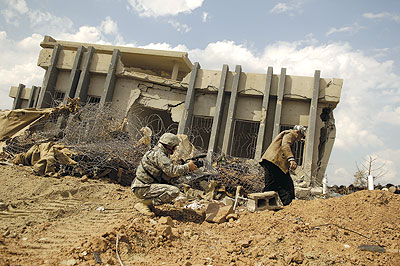
070404-F-2828D-108
The results of a suicide bombing.
Lieutenant-Colonel Tod Strickland, PPCLI, earned a Masters in Middle Eastern History from American Military University, as well as a Masters in Defence Studies and a Bachelor of Military Arts and Science from the Royal Military College of Canada. Recently promoted, he is now a planner with the Expeditionary Plans directorate of the Strategic Joint Staff.
Notes
- Hassane Mefthahi, and John Leicester, “Al-Qaida Claims Bloody Algiers Bombings,” in Herald-Zeitung, 11 December 2007. Available from <http://hosted.ap.org/dynamic/stories/ A/ALGERIA_EXPLOSION?SITE=TXNEW>; Internet accessed 11 December 2007.
- “Suicide Bomber Targets Offices of Ex-Iraqi PM and Sunni Lawmaker,” in International Herald Tribune, 11 December 2007. Available from <http://www.iht.com/articles/ap/2007/12/11/africa/ ME-GEN-Iraq-Violence.php>; Internet accessed 11 December 2007.
- “Suicide Bomber Targets Canadian Convoy in Panjwaii,” CTV.ca, 11 December 2007. Available from <http://www.ctv.ca/servlet/ArticleNews/story/CTVNews/20071211/convoy_panjwaii_071211/ 20071211?hub=World>; Internet accessed 11 December 2007.
- Michael P. Arena and Bruce A. Arrigo, The Terrorist Identity: Explaining the Terrorist Threat (New York: New York University Press, 2006), p. 140.
- David J. Whittaker, Terrorists and Terrorism in the Contemporary World (London: Routledge, 2004), p. 85.
- Christoph Reuter, My Life Is a Weapon: A Modern History of Suicide Bombing (Princeton: Princeton University Press, 2004), p. 55.
- Ibid., pp. 52-54.
- Ibid., p. 53. Note: Throughout this article, I will not name the attackers, whether they are known or not. It is my personal belief that recording their names is a form of commemoration.
- Rod Nordland, Babak Dehghanpisheh and Larry Kaplow, “Surge of Suicide Bombers,” in Newsweek, Volume 150, Issue 5, 13 August 2007, pp. 30-32. Available from <http://search.ebscohost.com/ login.aspx?direct=true&db=aph&AN=26085461&site=ehost-live>; Internet accessed 27 November 2007.
- Charles Krauthammer, “The Fine Art of Dying Well,” in Time, Volume 169, Issue 11, 12 March 2007, p. 72.
- Nordland, Dehghanpisheh, and Kaplow, “Surge of Suicide Bombers.”
- David J. Whittaker, Terrorists and Terrorism in the Contemporary World (London: Routledge, 2004), p. 37.
- For the purposes of this discussion, I have defined the Middle East to include both the coast of North Africa and the area as far east as Afghanistan. Although other regions have suffered this form of terrorism (Pakistan, Great Britain, Sri Lanka, and the United States of America, for example), the issue becomes too broad in scope to be addressed in this article, and those regions have therefore been omitted from the discussion at hand.
- Robert A. Pape, Dying to Win: The Strategic Logic of Suicide Terrorism (New York: Random House, 2005), p. 28.
- Michael Ignatieff, The Lesser Evil: Political Ethics in an Age of Terror (Toronto: Penguin, 2004), p. 69.
- “Gunman Slays 20 at Site of Mosque, Israel Reports Say,” in The New York Times, 25 February 1994. Available from <http://query.nytimes.com/gst/fullpage.html?res=9B00E6DF1F3BF936A15751C0A962958260&n=
Top/Reference/Times%20Topics/Organizations/P/Palestine%20Liberation%20Organization>; Internet accessed 12 December 2007. - J.B. Sykes (ed.), The Concise Oxford Dictionary of Current English: Seventh Edition (Oxford: Oxford University Press, 1989), p. 1067.
- Ibid., p. 621.
- Joyce M. Davis, Martyrs: Innocence, Vengeance, and Despair in the Middle East (New York: Palgrave Macmillan, 2003), pp. 8-9.
- I. W. Charney, Fighting Suicide Bombing: A Worldwide Campaign for Life (Westport, CT: Praeger, 2007), pp. 50-51.
- Ibid, p. 130.
- Pape, p. 23. It must be noted that Pape includes attackers from the entire globe, including the Tamil Tigers of Sri Lanka, whose profile may skew that of the typical attacker in the Middle East.
- Charney, p. 149. Interestingly, no data seems to have been collected as to the sex of the attacker.
- “School for Suicide,” Atlantic Monthly, Volume 299, Issue 4, May 2007, np. Available from <http://web.ebscohost.com/ehost/detail?vid=10&hid=2&sid=5371a550-35df-4181-844c-b>; Internet accessed 27 November 2007.
- Ibid. The Atlantic Monthly report was based upon a working paper by Efraim Benmelech and Claude Berrebi entitled, “Attack Assignments in Terror Organizations and The Productivity of Suicide Bombers” for the National Bureau of Economic Research. The data that they are using was collected by the Israeli Security Agency.
- Nordland, Dehghanpisheh, and Kaplow, “Surge of Suicide Bombers.”
- I was unable to find an open-source report of a female suicide bomber in Afghanistan. This may be because of the prevalence of tribal codes in governing the conduct of women, or it could just be that the technique has yet to migrate there. Female suicide bombers are also well known in Chechnya and Sri Lanka, as well as being reported in Pakistan.
- Charney, p. 49.
- Ibid., p. 48.
- Ibid.
- Pape, p. 11.
- Ibid., p. 27.
- Ibid., p. 21.
- Ibid., p. 41.
- Thucydides, The Peloponnesian War: The Melian Dialogue (Book 5, Chapter 17). Available from <http://www.wellesley.edu/ClassicalStudies/CLCV102/Thucydides--MelianDialogue.html>; Internet accessed 13 December 2007.
- Pape, p. 21.
- Ibid.
- Charney, p. 64.
- Lauri S. Friedman (ed.), What Motivates Suicide Bombers? (New York: Greenhaven Press, 2005).
- Pape, p. 96.
- Reuter, p. 58.
- Pape, p. 51.
- Ibid., p. 93.
- Aparisim Ghosh, “Inside the Mind of an Iraqi Suicide Bomber.” in Time, Volume 166, Issue 1, 4 July 2005, pp. 22-29. Available from <http://search.ebscohost.com/login.aspx?
direct=true
&db=aph&AN=17449103&site=ehost-live>; Internet accessed 28 November 2007. - Alan M. Dershowitz, Why Terrorism Works: Understanding the Threat, Responding to the Challenge (London: Yale University Press, 2002), p. 96.
- Charney, p. 155.
- Dershowitz, p. 80.
- Michael P. Arena and Bruce A. Arrigo, The Terrorist Identity: Explaining the Terrorist Threat (New York: New York University Press, 2006), p. 141.
- Reuter, p. 70.
- Arena, p. 141.
- Charney, p. 49.
- Alan S. Miller and Satoshi Kanazawa, “10 Politically Incorrect Truths about Human Nature,” in Psychology Today, Volume 40, Issue 4, July/August 2007, pp. 88-95. Available from <http://search.ebscohost.com/login.aspx?direct=true&db=aph&AN=25482787&site=ehost-live>; Internet accessed 27 November 2007.
- Nia Kfir, “Understanding Suicidal Terror Through Humanistic and Existential Psychology,” in The Psychology of Terrorism: Volume 1, A Public Understanding, ed. Chris E. Stout (Westport, Connecticut: Praeger, 2002), p. 143.
- Ibid., pp. 146-147.
- Pape, p. 32.
- Charney, pp. 64-65.
- Pape, p. 38.
- Reuter, p. 122. Shari’a is Islamic law.
- David Bukay, “The Religious Foundations of Suicide Bombings,” in Middle East Quarterly, Volume 13, Issue 4, Fall 2006, pp. 27-36. Available from <http://search.ebscohost.com/login.aspx?
direct=true&db=aph&AN=22861742&site=ehost-live>; Internet accessed 27 November 2007. - Ibid.
- Dershowitz, p. 80.
- Arena, pp. 140-141.
- Ibid., p. 140.
- Reuter, p. 64.
- Ibid.
- Ibid, p. 121.
- Arena, p. 141.
- Munwar A. Anees, “Salvation and Suicide: What Does Islamic Theology Say?” in Dialog: A Journal of Theology,Volume 45, Number 3, Fall 2006, p. 279.
- Ibid., p. 275.
- Ibid., p. 277.
- Reuter, p. 120.
- Ibid., p. 118.
- Ibid., p. 119.
- Bukay. This is the same sheikh who also argues that suicide attacks are legitimate, as detailed on Page 17 of reference. The dichotomy between his views is interesting, to say the least.
- Ibid.
- Anees, p. 277.
- The concept of a ‘wicked problem,’ whose solutions cause second and third order effects, which, in turn, cause further difficult problems, was first coined by social planners Horst Rittel and Melvin Webber in 1973.
- Pape, p. 238.
- Charney, p. 149.
- Harun Yahya, Islam Denounces Terrorism (Bristol, UK: Amal Press, 2002), p. 150.
- Charney, p. 158.
- Ibid., p. 152.
- Reuter, p. 178.
- Dershowitz, p. 29.
- Ami Pedahzur and Aeri Perliger, “The Changing Nature of Suicide Attacks: A Social Network Perspective,” in Social Forces, Volume 84, Number 4, June 2006, 1989.
- Karen Nitkin, “Detecting Suicide Bombers,” in Technology Review, March/April 2007, p. 22.
- Nancy Macdonald, “A Suicide Bomber’s Worst Friend,” in Maclean’s, Volume 120, Issue 20, 28 May 2007, p. 28.






